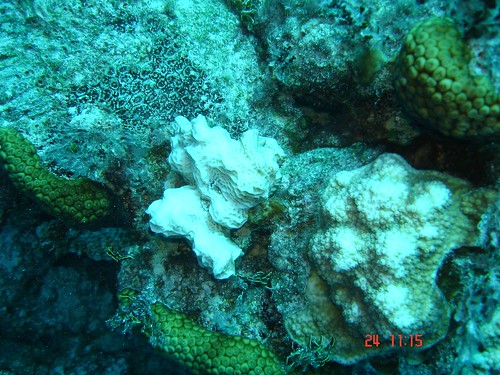Last April 9, British Petroleum's (BP) pursuit of profit caused the biggest oil spill in U.S. history. Seven months later, this crime against nature and society seems all but forgotten. BP and the oil and gas industry are given the green light by the Obama administration to resume/continue their operations in the Gulf of Mexico.
However, the ecological damages caused by the BP oil spill continue. And, from time to time, the mass media shed some light on it. The following article in the New York Times gives a sense of how coral reefs so important for ecosystems in the Gulf are dying from the oil spill.
By burying the lessons of the BP oil spill disaster in the Gulf of Mexico, the government and mass media continue to support the twine causes of ecological/environmental crisis of our time: climate change and the six great mass extinction of species. They are capitalism and industrialism powered by fossil fuel. Capitalism is the socioeconomic system that gives priority to profits over society and nature. Without the Industrial Revolutions powered by fossil fuels, modern day capitalism would have been impossible.
The task for the enlightened humanity is to rid society of alienated relations, most immediately, capitalist social relations. Towards this goal, it is necessary to educate and mobilize public opinion for alternative sources of energy. KN
* * *
By John Collins Rudolf, The New York Times, November 6, 2010
A survey of the seafloor near BP’s blown-out well in the Gulf of Mexico has turned up dead and dying coral reefs that were probably damaged by the oil spill, scientists said Friday.
The coral sites lie seven miles southwest of the well, at a depth of about 4,500 feet, in an area where large plumes of dispersed oil were discovered drifting through the deep ocean last spring in the weeks after the spill.
The large areas of darkened coral and other damaged marine organisms were almost certainly dying from exposure to toxic substances, scientists said.
The corals were discovered on Tuesday by scientists aboard a National Oceanic and Atmospheric Administration research vessel using a submersible robot equipped with cameras and sampling tools.
The documented presence of oil plumes in the area, the proximity to BP’s well and the recent nature of the die-off make it highly likely that the spill was responsible, said Charles Fisher, a marine biologist from Pennsylvania State University who is the chief scientist on the gulf expedition, which was financed by the federal government.
“I think that we have a smoking gun,” Dr. Fisher said. “The circumstantial evidence is very strong that it’s linked to the spill.”
The discovery of the dead corals offers the strongest evidence so far that oil from the BP well may have harmed marine life in the deep ocean, a concern raised by many biologists soon after the April 20 blowout that caused the spill. At an estimated nearly five million barrels, it was the largest offshore oil spill in the nation’s history.
A brownish substance covered many of the dead or dying reefs but was probably dead tissue and sediment, not oil, Dr. Fisher said.
Oil seeps naturally from the seafloor throughout the Gulf of Mexico, but that was unlikely to have caused such a severe coral die-off, he added.
“We have never seen anything like this at any of the deep coral sites that we’ve been to,” Dr. Fisher said. “And we’ve been to quite a lot of them.”
Further study is needed to conclusively link the coral die-off to the spill, scientists said, and the survey team took a number of samples from the site to test for the presence of hydrocarbons and dispersant.
Whether these samples will yield direct evidence leading back to the spill is unclear. “No one yet knows if the signature of whatever toxin killed these corals can be found in their skeletons after the tissue sloughs off,” Dr. Fisher said.
Jane Lubchenco, the administrator of the National Oceanic and Atmospheric Administration, called the findings significant. “Given the toxic nature of oil and the unprecedented amount of oil spilled, it would be surprising if we did not find damage,” she said in a statement. “This is precisely why we continue to actively monitor and evaluate the impact of the spill in the gulf.”
“We are determined to hold the responsible parties accountable for the damage done to the environment,” she added.
The ocean floor near the site of the well is still largely unexplored and is probably home to many other deep-water coral communities that scientists are eager to study.
The scientists will return to the same region on an expedition in December for more research, using a Navy vehicle that can accommodate two scientists and a pilot to depths of up to nearly 15,000 feet. Work on deep-water corals is typically conducted using advanced submersibles or remotely operated underwater vehicles.
Coral sites in shallower waters farther from the well have not suffered visible damage, scientists say, but they are still studying these reefs for signs of less acute long-term effects.
“There’s a lot of work to be done to see if there’s been some sublethal effect on these corals,” said Erik Cordes, a marine biologist from Temple University who has been studying reefs in the gulf in the aftermath of the spill.

Of course, left unmentioned here is the fact that--EVEN WITHOUT OIL DISASTERS LIKE THE ONE IN THE GULF--the oil still ends up being burned, loading the atmosphere with CO2, warming the climate & the oceans & causing MASSIVE CORAL BLEACHING all over the planet. It also causes ocean acidification that threatens to wipe out the tiny zooplankton and corals that can no longer produce their protective calcium shells.
ReplyDelete